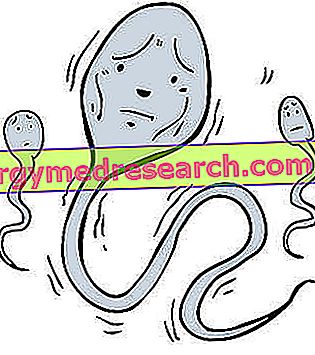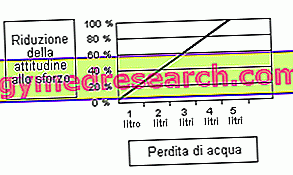Generality
Astenozoospermia is the condition suffered by men who produce ejaculations with reduced content of mobile spermatozoa.

The causes and risk factors of asthenozoospermia include conditions such as varicocele, alcohol abuse, smoking, illegal drug use, genital infections, testicular cancer, teratozoospermia, nutritional deficiencies, and serious feverish states etc.
To remedy asthenozoospermia, it is essential to treat its triggers.
Short review of what sperm are
Sperm are the male gametes, ie the cells that, in men, are deputies to the reproductive function.
Produced from the testicles (the male gonads ), on the occasion of the so-called spermatogenesis, the spermatozoa are very small cellular elements (5-7 micrometers) and have a very particular structure, which includes:
- A head, containing the cell nucleus and acrosome ;
- An intermediate portion, rich in mitochondria;
- A tail, equipped with mobility and called a flagellum .
The particular morphology of the spermatozoa is fundamental for the reproductive process, as it allows them to meet and fuse with an egg cell, inside the female genital apparatus.
What is asthenozoospermia?
Astenozoospermia is the medical voice that indicates the reduction, below a reference value corresponding to normality, of the percentage of motile spermatozoa in the ejaculate, ie in the product of ejaculation .
Astenozoospermia is a condition that attracts great interest among men wishing to have children, as a reduced number of motile spermatozoa is associated with a decrease in male fertility ( male infertility ).
Definition of asthenozoospermia according to the WHO
According to the World Health Organization (WHO), a man suffers from asthenozoospermia in two circumstances:
- When less than 32% of its sperm has progressive motility
or alternatively,
- When the sum between the percentage share of spermatozoa with progressive motility and the percentage share of spermatozoa with non-progressive motility (sum that, in technical jargon, is called total motility ) is less than 40%.
At this point, for the less experienced and those who have doubts, it is right to define the items "progressive motility", "non-progressive motility" and "total motility" of the spermatozoa:
- Progressive motility → The spermatozoa exhibit progressive motility which, on analysis of their ability to move, show that they know how to move in a straight line. For reproductive purposes, a large proportion of spermatozoa with progressive motility is ideal;
- Non-progressive motility → Spermatozoa exhibit non-progressive motility which, after an analysis of their movement capacity, moves but is absolutely not in a straight line. For reproductive purposes, a large amount of spermatozoa with non-progressive motility is negative.
- Total motility → This term includes all spermatozoa with a certain motility, regardless of whether the latter is progressive or non-progressive, and excludes all motionless spermatozoa, ie incapable of moving.
Table . Reference values that sanction the normality of a human ejaculate, according to the latest indications from the WHO (2010).
| Parameter | Unit of measure | Reference values |
| Ejaculate volume | Milliliter (ml) | > 1.5 ml |
| Sperm concentration | Millions per milliliter (Millions / ml) | > 15 million / ml |
| Total number of spermatozoa | Millions | > 39 million |
| Total sperm motility | % spermatozoa | > 40% |
| Progressive sperm motility | % spermatozoa | > 32% |
| Sperm vitality (viable spermatozoa) | % spermatozoa | > 58% |
| Spermatozoa with normal morphology | % spermatozoa | > 4% |
Epidemiology
Statistical data on the spread of asthenozoospermia in the male population are very scarce and not very real.
The only sufficiently reliable information, regarding the aforementioned topic (spread of asthenozoospermia ), concerns the number of men with complete asthenozoospermia (*): one for every 5, 000 male individuals.
* NB: "complete asthenozoospermia" is the term that indicates the complete absence, in an ejaculate, of mobile spermatozoa.
Synonyms of astenozoospermia
In the medical field, asthenozoospermia is also known as asthenospermia .
Origin of the name
The words "astenozoospermia" and "astenospermia" derive from the union of three terms of Greek origin, which are:
- The privative alpha corresponding to the initial vowel "a", whose meaning is "without";
- "Steno" from " stenos " ( σϑένος ), which means "strength";
- "Sperm" from " sperm " ( σπέρμα ), which means "seed".
Therefore, literally, asthenozoospermia means "without strength in the seed" or "lack of strength in the seed" (where by semen is meant, obviously, the sperm and, specifically, the sperm population).
Causes
Doctors and researchers believe that various conditions appear in the list of causes and risk factors for asthenozoospermia, including:
- The presence of particular antibodies that "attack" the spermatozoa ( anti- spermatozoa antibodies or anti- sperm antibodies );
- Alcohol abuse, smoking or excessive consumption of drugs such as hashish or marijuana;
- Age exceeds 45 years. Statistical studies have shown that, starting from this age, in men, there is a slow reduction in sperm motility;
- Exposure to toxic agents, such as pesticides, fertilizers, chemical solvents, etc .;
- The presence of a genital infection, in charge of one of those organs in which sperm and seminal fluid usually flow (prostate, seminal vesicles, epididymis and urethra);
- The presence of a testicular disease (eg: testicular tumor or hydrocele );
- Teratozoospermia . It is an abnormality of the sperm, characterized by the presence of malformed spermatozoa (eg spermatozoa without the tail);
- The varicocele . It is a pathological alteration of the testicular (or spermatic) veins, due to which the latter appear dilated and one or both testicles are swollen;
- Nutritional deficiencies, due to an inadequate diet;
- Severe feverish states or sequelae of severe febrile states;
- Chemotherapy and / or radiotherapy, performed during a tumor treatment;
- The habit of behaviors that produce a rise in temperature at the testicular level (eg: the repeated practice of saunas, the tendency to wear tight-fitting clothes, etc.).
Symptoms and complications
On its own, asthenozoospermia does not cause physical symptoms; however, it is fairly widely associated with symptomatic pictures, as - as reported in the previous chapter - it is often linked to widely symptomatic conditions.
So, for example, in the case of asthenozoospermia due to varicocele, it is likely that the affected subject will have a dull testicle pain, a swollen testicle, a pain in the groin area, etc., in addition to a reduced number of motile spermatozoa.
Complications
As stated, men with severe astenozoospermia tend to develop a degree of infertility, which does not allow them to have children.
When should I go to the doctor?
A man with asthenozoospermia should contact a doctor, especially a urologist or andrologist, when:
- He is eager to have children, but the condition of which he suffers is an obstacle to this desire;
- It manifests an associated symptom picture incompatible with the conduct of a normal life. In this case, the cause of asthenozoospermia is a condition having a certain clinical relevance, which deserves the due attention and adequate treatment.
Diagnosis
To diagnose asthenozoospermia, doctors rely on an examination known as a spermiogram .
The spermiogram is a laboratory investigation that allows to observe a series of important characteristics of a sperm sample, in order to evaluate the fertility of the man to whom the aforementioned sperm sample belongs.
Among the characteristics of the sperm, detected by spermiogram, are:
- Sperm viscosity,
- The sperm liquefaction,
- Sperm count and
- Sperm motility.
Once the presence of asthenozoospermia has been ascertained, the next step consists in searching for the causes that trigger the reduction of sperm motility; this research may require the execution of various diagnostic tests, including instrumental examinations.
The basic rules for obtaining a reliable spermiogram
In order for the outcome of a spermiogram to be reliable, it is essential to comply with some preparatory rules for the aforementioned laboratory test; entering more into details, these preparatory rules are:
- Complete abstinence from sexual activity for 3-5 days prior to the exam;
- Ejaculation obtained exclusively by masturbation;
- Before masturbation, provide adequate hand and penis hygiene;
- Provide for the collection of all the sperm produced (so take care to press the penis even after the most important sperm emissions, so as to also take the later sperm);
- Collect in a clean place;
- For collection, use a suitable and sterile container (the classic urine containers are appropriate);
- Close the used container tightly, so as to avoid accidental loss of the collected sperm sample;
- After collecting the sample, send the sperm sample to the analysis laboratory as soon as possible (within 30-60 minutes), avoiding thermal shocks. Nowadays, these problems no longer exist, because the analysis laboratories grant the possibility, to the examined, to carry out the collection in a bathroom of the structure;
- Inform the medical staff of the laboratory of any therapies or diseases followed or occurred in the last three months;
- Inform the medical staff of the laboratory of any failure to comply with one of the aforementioned preparatory standards, in order to understand whether it is necessary to repeat the semen sample collection procedure.
Examinations for research into the causes of asthenozoospermia
The search for what causes asthenozoospermia always begins with an objective examination and a medical history ; therefore, also based on what emerged from these two tests mentioned above, it can continue with: a blood and urine test, a spermioculture, an ultrasound of the testicles, an ultrasound of the lower abdomen etc.
Therapy
Astenozoospermia therapy is based on the cure or elimination of the triggering factor .
Thus, for example, in men with varicocele asthenospermia, it will be the treatment of the latter that represents the remedy against the reduced presence of motile spermatozoa.
As is easily imaginable, among the causes of asthenozoospermia, triggering conditions exist that are more successful than others, and this obviously has repercussions on the degree of restoration of normal sperm motility.
Astenozoospermia, infertility and assisted reproduction in vitro
For some time now, men eager to have children but unable to have them because they have astenozoospermia can count on a particular in vitro assisted reproduction technique, known as ICSI or intracytoplasmic injection .
Without going into too much detail, ICSI provides for the specific collection, from a sample of ejaculate, of spermatozoa with progressive motility, the selection of one of these and its inoculation, in vitro, in an egg cell.
Currently, ICSI is one of the most effective non-conventional IVF techniques that can be exploited by men with asthenozoospermia problems and desiring paternity.



